Niña De Los Peines - De Sevilla A Cadiz
Table of Contents
Download
Filename: nia-de-los-peines-de-sevilla-a-cadiz.rar- MP3 size: 13.2 mb
- FLAC size: 195.2 mb
Tracks
| Track | Duration | Preview |
|---|---|---|
| De Sevilla A Cadiz | ||
| Las Fatigas Me Ahogaban. A Dios Le Estoy Rogando. Puesto En El Altar Mayor. Mucho Te Quiero | ||
| Fiestas De Pastora | ||
| Se Le Han Corrido Los Velos. Si A la Derecha Te Inclinas |
Images

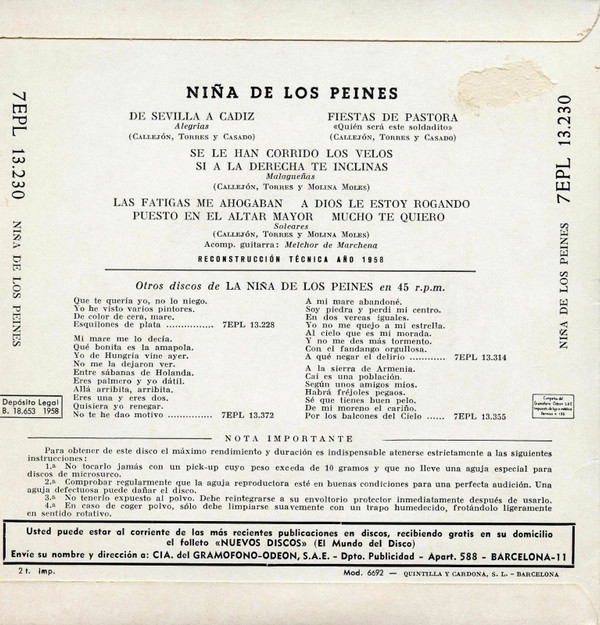

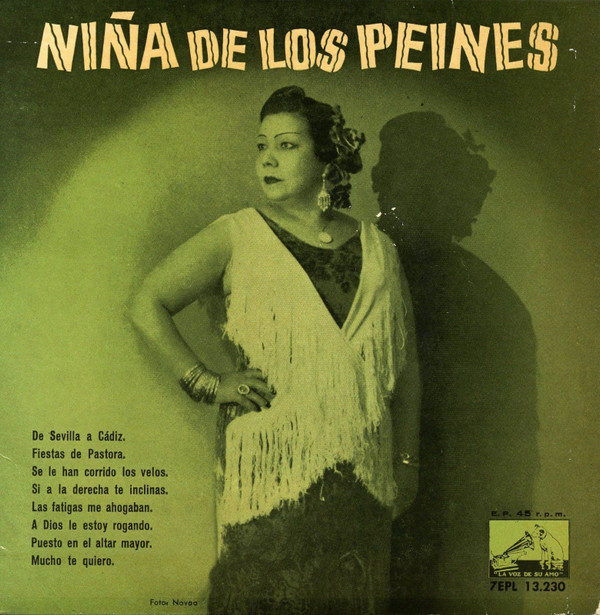
Catalog Numbers
7EPL 13.230Labels
La Voz De Su AmoListen online
- online anhören
- ouvir online
- escuchar en línea
- kuunnella verkossa
- lytte på nettet
- écouter en ligne
- ascolta in linea
- online luisteren
- lyssna på nätet
Formats
- Vinyl
- 7"
- 45 RPM
- EP
- Reissue
Companies
| Role | Company |
|---|---|
| Record Company | Compañia Del Gramofono-Odeon, S.A.E. |
| Printed By | Quintilla Y Cardona, S. L. |
Notes
Reconstrucción Técnica Año 1958Barcodes
Depósito Legal: B. 18653-1958About Niña De Los Peines
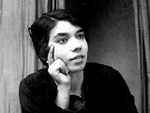
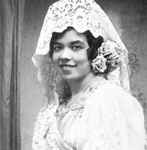
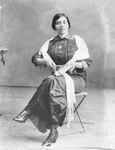

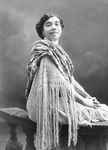

Pastora Pavón Cruz, known as La Niña de los Peines (Seville, Spain, February 10, 1890 - November 26, 1969), is considered the most important female flamenco singer from the 20th century. She was sister of singers Arturo Pavón and , and aunt to , the first flamenco pianist. Both brothers, Pastora and Tomás, together with singer Manuel Torre, were the inspiring models for the next generation of singers like Antonio Mairena, Pepe de la Matrona or Fosforito, who led the movement towards the revival of traditional forms in the decades of the 50s-70s.
Born in the famous quarter of Alameda de Hércules, in Seville, she started singing for the public at the age of 8, in the "Feria de Sevilla". Later, when she was singing at Café de la Marina, a café cantante in Madrid, she began to be known as La Niña de los Peines (The Girl of the Combs, a nickname she never liked), as she usually sang a stanza in tangos style with the following lyrics: "Peinate tú con mis peines / Mis peines son de canela".
She never learnt to read or write, and only learnt to sign when she was already an adult. Her family were in dire need of money, so she started to sing regularly as a professional in the Taberna de Ceferino, in Seville, and then spent a period in Madrid and Bilbao. In this town, she was not allowed to sing in public owing to her young age, so she sat as model for painter Ignacio Zuloaga. Back in Andalusia, she took part in the performances of several cafés cantante in Jerez, Seville, Málaga and other towns. In 1910 she made her first recordings, and in 1920 the Teatro Romea was paying her the highest fee it had ever paid to an artist. After that, she started a long series of tours through all Spain.
In 1922 at Granada, she participated at the Concurso de Cante Jondo. This famous music festival was largely organized by Manuel de Falla and also Federico García Lorca in order to reinvigorate the flamendo arts. She was featured as a professional performer, along with Antonio Chacón, Manuel Torre, Juana la Macarrona, Ramón Montoya and others. She was also chosen as one of the judges for the contest between non-professionals.
Along her career she met or shared the stage with many classical flamenco singers of the Golden Age like Antonio Chacón, Manuel Torre, Francisco Lema (known as Fosforito El Viejo), El Canario, La Trini, or Frijones. She had also met in 1922 Federico García Lorca, who, in a lecture given in 1933, stated: "This woman's voice is exceptional. It breaks the moulds of all singing schools, as much as she breaks the moulds of any built music. When she seems to be out of tune, she is not out of tune: on the contrary, she is incredibly in tune as, owing to the special miracle of this style and the passion with which she sings third tones and quarter tones, impossible to record on the staff." (Quoted by Antonio Reina in Museo Virtual de la Niña de los Peines)
In 1931, she married flamenco singer (he was 13 years younger). After the parenthesis of the Spanish Civil War, she came back to the stage, as part of several flamenco shows, together with artists like Concha Piquer. After this, she retired for a few years, and came back with a show called España y su Cantaora (Spain and her singer), together with her husband, which she toured for a few months and was acclaimed by the critics. Then she definitely retired again. In 1961 she received an homage in Córdoba, in which several well-known flamenco artists took part, such as Antonio Mairena, Juan Talega, Manuel Morao, or Fernando Terremoto. In 1968, a monument was built in her honour in her quarter of Alameda de Hércules. In the last three years of her life, she was completely retired owing to senile dementia. She died in 1969, a month and a half after her husband. In that same year, singer Anotnio Mairena recorded his album Honores a la Niña de los Peines in homage to her. In 1996, during the IX Bienal de Flamenco, the autonomous Andalusian government declared the voice of La Niña de los Peines Bien de Interés Cultural (Asset of Cultural Interest).
Real Name
- Pastora María Pavón Cruz
Name Vars
- \
- La Nina De Los Peines
- Nina De Los Peines
- Niña De Los Peines
- Niña de los Peines
Related albums
2001
1997
2004

2008
2006
2015
2005
2019
2008
2011

2011
2013
2011
2019

2012
1999

1959

1981